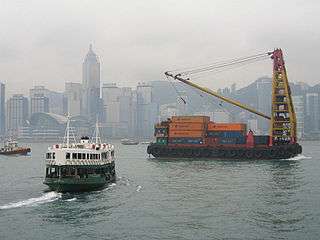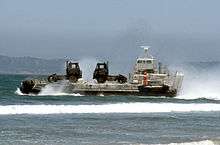Lighter (barge)



A lighter is a type of flat-bottomed barge used to transfer goods and passengers to and from moored ships. Lighters were traditionally unpowered and were moved and steered using long oars called "sweeps" and the motive power of water currents. They were operated by highly skilled workers called lightermen and were a characteristic sight in London's docks until about the 1960s, when technological changes made this form of lightering largely redundant. Unpowered lighters continue to be moved by powered tugs, however, and lighters may also now themselves be powered. The term is also used in the Lighter Aboard Ship (LASH) system.
The name itself is of uncertain origin, but is believed to possibly derive from an old Dutch or German word, lichten (to lighten or unload). In Dutch, the word lichter is still used for smaller ships that take over goods from larger ships.
The lighter barge gave rise to the "lighter tug", a small, maneuverable type of harbour tug. Lighter tugs—or simply "lighters"—are designed for towing lighter barges. As such, they are smaller than traditional harbour tugs and lack the power or equipment to handle large ships.
Lighters, albeit powered ones, were proposed to be used in 2007 at Port Lincoln and Whyalla in South Australia to load Capesize ships which are too big for the shallower waters close to shore.[1][2]
Hong Kong widely uses lighters in midstream operations where lighters transport cargo, mostly containers, between oceangoing vessels or to and from terminals. Lighters in Hong Kong are usually equipped with cranes of 40-60 tonnes capacity, and the largest ones can carry up to 300 TEU containers (empties). Lighters are not fitted with engines but are towed by tugboats. In 2007, midstream operators handled about 2 million TEUs and 5 million TEUs were transported as river trade cargo which are heavily dependent on lighters.
See also
References
- ↑ "Onesteel says no to barge sharing". Australian Mining. www.miningaustralia.com.au. December 27, 2007. Retrieved 2010-06-17.
- ↑ Geoscience Australia. "Iron Ore - AIMR 2008 Preliminary - Australian Mines Atlas". www.australianminesatlas.gov.au. Retrieved 2010-06-17.